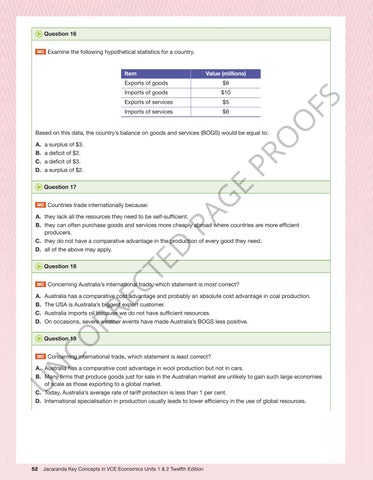“c06TheEconomicsOfInternationalTrade_PrintPDF” — 2022/5/31 — 13:29 — page 52 — #52
Question 16 Examine the following hypothetical statistics for a country.
Item
Value (millions) $8
Imports of goods
$10
Exports of services
$5
Imports of services
$6
FS
Exports of goods
PR
a surplus of $3. a deficit of $2. a deficit of $3. a surplus of $2.
E
A. B. C. D.
O
Based on this data, the country’s balance on goods and services (BOGS) would be equal to:
G
Question 17 Countries trade internationally because:
PA
MC
O
MC
Question 18
A. B. C. D.
Concerning Australia’s international trade, which statement is most correct?
CO RR EC
MC
TE
D
A. they lack all the resources they need to be self-sufficient. B. they can often purchase goods and services more cheaply abroad where countries are more efficient producers. C. they do not have a comparative advantage in the production of every good they need. D. all of the above may apply.
Australia has a comparative cost advantage and probably an absolute cost advantage in coal production. The USA is Australia’s biggest export customer. Australia imports oil because we do not have sufficient resources. On occasions, severe weather events have made Australia’s BOGS less positive.
Question 19
Concerning international trade, which statement is least correct?
N
MC
U
A. Australia has a comparative cost advantage in wool production but not in cars. B. Many firms that produce goods just for sale in the Australian market are unlikely to gain such large economies of scale as those exporting to a global market. C. Today, Australia’s average rate of tariff protection is less than 1 per cent. D. International specialisation in production usually leads to lower efficiency in the use of global resources.
52
Jacaranda Key Concepts in VCE Economics Units 1 & 2 Twelfth Edition





















































